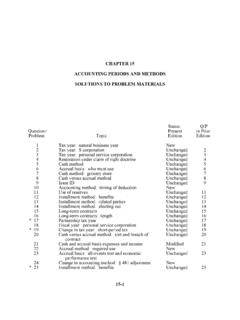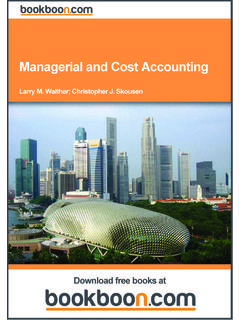Transcription of KiesIA 13e SM Ch11 Final
1 CHAPTER 11. Depreciation, Impairments, and Depletion ASSIGNMENT CLASSIFICATION TABLE (BY TOPIC). Brief Concepts Topics Questions Exercises Exercises Problems for Analysis 1. Depreciation methods ; 1, 2, 3, 4, 5, 1, 2, 3, 4, 5, 1, 2, 3 1, 2, 3, 4, 5. meaning of depreciation; 6, 10, 14, 8, 14, 15. choice of depreciation 20, 21, 22, methods . 29, 30. 2. Computation of 7, 8, 9, 1, 2, 3, 4 1, 2, 3, 4, 1, 2, 3, 4, 1, 2, 3. depreciation. 13, 31 5, 6, 7, 8, 10, 11, 10, 15 12. 3. Depreciation base. 6 5 8, 14, 16 1, 2, 3, 3. 8, 10. 4. Errors; changes in 13 7 11, 12, 3, 4 3. estimate. 13, 14. 5. Depreciation of partial 15 2, 3, 4 3, 4, 5, 6, 1, 2, 3, periods . 7, 15 10, 11. 6. Composite method. 11, 12 6 9 2. 7. Impairment of value. 16, 17, 18, 8 16, 17, 18 9. 19, 29, 30, 31, 32. 8. Depletion. 22, 23, 24, 9 19, 20, 21, 5, 6, 7. 25, 26, 27 22, 23. 9. Ratio analysis. 28 10 24. *10. Tax depreciation 33 11 25, 26 12.
2 (MACRS). *This material is covered in an Appendix to the chapter. Copyright 2010 John Wiley & Sons, Inc. Kieso, Intermediate accounting , 13/e, Solutions Manual (For Instructor Use Only) 11-1. ASSIGNMENT CLASSIFICATION TABLE (BY LEARNING OBJECTIVE). Brief Learning Objectives Exercises Exercises Problems 1. Explain the concept of depreciation. 2. Identify the factors involved in the depreciation 2, 3, 4, 5, 7 1, 2, 3, 4, 5, 6, 1, 2, 3, process. 7, 8, 9, 10, 11, 4, 8, 10, 12, 13, 14, 15 11, 12. 3. Compare activity, straight-line and decreasing- 2, 3, 4 1, 2, 3, 4, 5, 6, 1, 2, 3, 4, charge methods of depreciation. 7, 8, 9, 10, 11, 5, 8, 10, 12, 13, 14, 15 11, 12. 4. Explain special depreciation methods . 1, 6. 5. Explain the accounting issues related to asset 8 16, 17, 18 9. impairment. 6. Explain the accounting procedures for 9 19, 20, 21, 5, 6, 7. depletion of natural resources. 22, 23. 7. Explain how to report and analyze property, 10 24.
3 Plant, equipment, and natural resources. *8. Describe income tax methods of depreciation. 11 25, 26 12. 11-2 Copyright 2010 John Wiley & Sons, Inc. Kieso, Intermediate accounting , 13/e, Solutions Manual (For Instructor Use Only). ASSIGNMENT CHARACTERISTICS TABLE. Level of Time Item Description Difficulty (minutes). E11-1 Depreciation computations SL, SYD, DDB. Simple 15 20. E11-2 Depreciation conceptual understanding. Moderate 20 25. E11-3 Depreciation computations SYD, DDB partial periods . Simple 15 20. E11-4 Depreciation computations five methods . Simple 15 25. E11-5 Depreciation computations four methods . Simple 20 25. E11-6 Depreciation computations five methods , partial periods . Moderate 20 30. E11-7 Different methods of depreciation. Simple 25 35. E11-8 Depreciation computation replacement, nonmonetary Moderate 20 25. exchange. E11-9 Composite depreciation. Simple 15 20. E11-10 Depreciation computations, SYD.
4 Simple 10 15. E11-11 Depreciation change in estimate. Simple 10 15. E11-12 Depreciation computation addition, change in estimate. Simple 20 25. E11-13 Depreciation replacement, change in estimate. Simple 15 20. E11-14 Error analysis and depreciation, SL and SYD. Moderate 20 25. E11-15 Depreciation for fractional periods . Moderate 25 35. E11-16 Impairment. Simple 10 15. E11-17 Impairment. Simple 15 20. E11-18 Impairment. Simple 15 20. E11-19 Depletion computations timber. Simple 15 20. E11-20 Depletion computations oil. Simple 10 15. E11-21 Depletion computations timber. Simple 15 20. E11-22 Depletion computations mining. Simple 15 20. E11-23 Depletion computations minerals. Simple 15 20. E11-24 Ratio analysis. Moderate 15 20. *E11-25 Book vs. tax (MACRS) depreciation. Moderate 20 25. *E11-26 Book vs. tax (MACRS) depreciation. Moderate 15 20. P11-1 Depreciation for partial period SL, SYD, and DDB.
5 Simple 25 30. P11-2 Depreciation for partial periods SL, Act., SYD, and DDB. Simple 25 35. P11-3 Depreciation SYD, Act., SL, and DDB. Moderate 40 50. P11-4 Depreciation and error analysis. Complex 45 60. P11-5 Depletion and depreciation mining. Moderate 25 30. P11-6 Depletion, timber, and extraordinary loss. Moderate 25 30. P11-7 Natural resources timber. Moderate 25 35. P11-8 Comprehensive fixed asset problem. Moderate 25 35. P11-9 Impairment. Moderate 15 25. P11-10 Comprehensive depreciation computations. Complex 45 60. Copyright 2010 John Wiley & Sons, Inc. Kieso, Intermediate accounting , 13/e, Solutions Manual (For Instructor Use Only) 11-3. ASSIGNMENT CHARACTERISTICS TABLE (Continued). Level of Time Item Description Difficulty (minutes). P11-11 Depreciation for partial periods SL, Act., SYD, Moderate 30 35. and DDB. *P11-12 Depreciation SL, DDB, SYD, Act., and MACRS. Moderate 25 35. CA11-1 Depreciation basic concepts.
6 Moderate 25 35. CA11-2 Unit, group, and composite depreciation. Simple 20 25. CA11-3 Depreciation strike, units-of-production, obsolescence. Moderate 25 35. CA11-4 Depreciation concepts. Moderate 25 35. CA11-5 Depreciation choice ethics Moderate 20 25. 11-4 Copyright 2010 John Wiley & Sons, Inc. Kieso, Intermediate accounting , 13/e, Solutions Manual (For Instructor Use Only). SOLUTIONS TO CODIFICATION EXERCISES. CE11-1. (a) The master glossary provides two entries for amortization: Amortization The process of reducing a recognized liability systematically by recognizing revenues or reducing a recognized asset systematically by recognizing expenses or costs. In pension accounting , amortization is also used to refer to the systematic recognition in net pension cost over several periods of amounts previously recognized in other comprehensive income, that is, prior service costs or credits, gains or losses, and the transition asset or obligation existing at the date of initial application of Subtopic 715-30.
7 Amortization The process of reducing a recognized liability systematically by recognizing revenues or by reducing a recognized asset systematically by recognizing expenses or costs. [In accounting for postretirement benefits, amortization also means the systematic recognition in net periodic postre- tirement benefit cost over several periods of amounts previously recognized in other comprehen- sive income, that is, gains or losses, prior service cost or credits, and any transition obligation or asset.]. (b) Impairment is the condition that exists when the carrying amount of a long-lived asset (asset group) exceeds its fair value. (c) Recoverable amount is the current worth of the net amount of cash expected to be recoverable from the use or sale of an asset. (d) According to the glossary, the term activities is to be construed broadly. It encompasses physical construction of the asset. In addition, it includes all the steps required to prepare the asset for its intended use.
8 For example, it includes administrative and technical activities during the precon- struction stage, such as the development of plans or the process of obtaining permits from governmental authorities. It also includes activities undertaken after construction has begun in order to overcome unforeseen obstacles, such as technical problems, labor disputes, or litigation. CE11-2. According to FASB ASC 360-10-40-4 through 6 (Impairment or Disposal of Long-Lived Assets .. Long-Lived Assets to Be Exchanged or to Be Distributed to Owners in a Spinoff): 40-4 For purposes of this Subtopic, a long-lived asset to be disposed of in an exchange measured based on the recorded amount of the nonmonetary asset relinquished or to be distributed to owners in a spinoff is disposed of when it is exchanged or distributed. If the asset (asset group). is tested for recoverability while it is classified as held and used, the estimated future cash flows used in that test shall be based on the use of the asset for its remaining useful life, assuming that the disposal transaction will not occur.
9 In such a case, an undiscounted cash flows recoverability test shall apply prior to the disposal date. In addition to any impairment losses required to be recognized while the asset is classified as held and used, and impairment loss, if any, shall be recognized when the asset is disposed of if the carrying amount of the asset (disposal group). exceeds its fair value. The provisions of this Section apply to nonmonetary exchanges that are not recorded at fair value under the provisions of Topic 845. Copyright 2010 John Wiley & Sons, Inc. Kieso, Intermediate accounting , 13/e, Solutions Manual (For Instructor Use Only) 11-5. CE11-2 (Continued). 40-5 A gain or loss not previously recognized that results from the sale of a long-lived asset (disposal group) shall be recognized at the date of sale. 40-6 See paragraphs 360-10-35-47 through 35-48 for guidance related to the disposition of an asset upon its abandonment.
10 CE11-3. According to FASB ASC 360-10-35-1 through 10 (Subsequent Measurement): 35-1 This Subsection addresses property, plant, and equipment, subsequent measurement issues related to depreciation and the acquisition of an interest in the residual value of a leased asset. 35-2 This guidance addresses the concept of depreciation accounting and the various factors to consider in selecting the related periods and methods to be used in such accounting . 35-3 Depreciation expense in financial statements for an asset shall be determined based on the asset's useful life. 35-4 The cost of a productive facility is one of the costs of the services it renders during its useful economic life. Generally accepted accounting principles (GAAP) require that this cost be spread over the expected useful life of the facility in such a way as to allocate it as equitably as possible to the periods during which services are obtained from the use of the facility.


